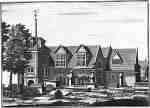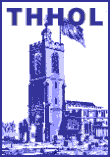When, in 1783, Dr. Johnson talked of the wonderful extent and variety of London, and observed that men of curious inquiry might see in it such modes of life as very few could ever imagine, he particularly recommended his friends William Windham and James Boswell to explore Wapping, which they resolved to do.
Almost ten years went by before the visit was made, Windham reluctantly giving up being present at an encounter between two noted pugilists. In his Diary on 27 October 1792, he says: "I let myself foolishly be drawn by Boswell to explore, as he called it, Wapping, instead of going when everything was prepared, to see the battle between Ward and Stanyard, which turned out to be a good one." As to Boswell, he relates that, "Whether from the uniformity which has in a great degree spread through every part of the metropolis, or our want of sufficient exertion, we were disappointed." Of course it may have been that the pair arrived during a quiet period of the day, or when it happened that there was a lull in the maritime activities occasioned by contrary winds holding up the shipping at the mouth of the Thames; but it is more likely that the scene in Dr. Johnson's mind was of the time when England being at war with France, Wapping was indeed busy in shipping supplies. In 1792 there was no war: the French Revolution had broken out. The "want of sufficient exertion" would, however, seem to suggest the suspicion that their coach had deposited the inquisitive visitors in the neighbourhood of the Tower, where agreeable refreshment and entertainment afforded a more genial attraction than any which might be found in going onwards afoot to observe, with curious eye and philosophic mind, the riverside population. It is most unlikely that their purpose was to observe poverty and distress which could be easily seen in the heart of London off the Strand, and in St. Giles-in-the-Fields and St. James', Westminster.
To explore Wapping now with the object of making sensational discoveries would lead to finding little gratification unless the knowledge of the conditions that once prevailed there stimulated the imagination to recall the past in contrast to the contemplation of the present. The mere mention of its name of Wapping brings up a picture of the district at its worst period; when it had become notorious as the resort of thieves and receivers of stolen goods, and depraved men and women. But better days had been seen before these things had come to pass, and it would be wrong to suppose that the Wapping of the beginning of the seventeenth century and that of a hundred years later was anything like what it became in the first half of the nineteenth century. As it is to-day, with the high brick-walled docks, tall warehouses and with hearly all its old streets swept away, few persons not knowing the history of its career would suspect that in this modernized, dull and respectable locality such variety of life once existed as appealed to so great a moralist as Dr. Johnson who, had he seen only vice and misery there, would have stoutly exposed and condemned it, and would not have enjoined his friends to go there in pure curiosity.
 The
name of Wapping was at one time borne by two hamlets, and the one situated away from the river
was distinguished as Wapping-Stepney from being in that parish, and which afterwards, in 1727,
was formed into the parish of St. George-in-the-East. The other hamlet, which was constituted
a parish in 1694 by an Act of Parliament, had been previously a hamlet of Whiteehapel, and was
reckoned to be in size one-eighth of the area of its mother parish. A chapel dedicated to St.
John the Baptist and con secrated 7 July 1617, had been erected at the expense of the inhabitants
and several citizens of London, then became the parish church. It was rebuilt in 1756, and demolished
in 1790 when the present church, dedicated to St. John the Evangelist, was erected. The illustration
[above right] shows the old church, the architecture of which is somewhat peculiar,
its general aspect being somehow suggestive of Dutch or Scandinavian taste. It will be observed,
too, that the burial mounds in the churchyard are decked by a kind of pall of a network of flowers,
which is not a familiar custom.
The
name of Wapping was at one time borne by two hamlets, and the one situated away from the river
was distinguished as Wapping-Stepney from being in that parish, and which afterwards, in 1727,
was formed into the parish of St. George-in-the-East. The other hamlet, which was constituted
a parish in 1694 by an Act of Parliament, had been previously a hamlet of Whiteehapel, and was
reckoned to be in size one-eighth of the area of its mother parish. A chapel dedicated to St.
John the Baptist and con secrated 7 July 1617, had been erected at the expense of the inhabitants
and several citizens of London, then became the parish church. It was rebuilt in 1756, and demolished
in 1790 when the present church, dedicated to St. John the Evangelist, was erected. The illustration
[above right] shows the old church, the architecture of which is somewhat peculiar,
its general aspect being somehow suggestive of Dutch or Scandinavian taste. It will be observed,
too, that the burial mounds in the churchyard are decked by a kind of pall of a network of flowers,
which is not a familiar custom.
The boundaries defined by the Act are very irregular, and some readers who know the neighbourhood and think of Wapping as being between the docks and the river, will be surprised to learn that the parish, which has the shape of a sickle, reaches northwards so far as Wellelose Square. On the west the limit is Nightingale Lane, and on the east the line passes outside what was once Prusoms Island, which is now occupied by Wapping Gas Works - these standing partly in the parishes of St. George-in-the-East and Shadwell. The river frontage of the parish on the south measures about 1,053 yards and extends from Hermitage&mdashthe entrance to London Docks to Frying Pan Stairs. These Stairs have been removed - they were there in 1830 - but their site is indicated by a spot thirty-five feet west of the Commercial Gas Company's landing-stage.
Through common usage, the name of Wapping is a geographical expression of a locality, and is not only applied to the actual parish. Until the middle of the sixteenth century, much land immediately contiguous to the river was covered by the tides, and hereby was "the usual place of execution for the hanging of pirates and sea rovers, at low-water mark, and there to remain till three tides had overflowed them." (Stow)
During the reign of Henry VIII much work was done in reclaiming marsh in England, especially in the Fen district, and the success which had attended these efforts induced a Dutchman, Cornelius Vanderdelf, to offer to undertake to drain 130 acres alongside the Thames between Hermitage and Foxes Lane (approximately Glamis Road). To enable the work to be carried out, a private Act of Parliament was passed in 1536, and to encourage Vanderdelf in his endeavours it gave him the title to half the land that was recovered.
By another Act, in 1541, Wapping Marsh was to be divided by certain persons, and Cornelius Vanderdelf being drowned, the moiety that was to have been his share was assigned to Richard Hill, citizen and mercer.
The wall or embankment was no sooner completed than in 1565 great breaches were made in various parts of it, followed by further damage with worse consequences in 1571. It was thereupon decided that the most effectual way to secure the bank of the river in these parts would be to erect buildings thereon, and accordingly the first foundations of houses were laid on the spot where Wapping is now situated.
That which had been a wash and a lonely waste of mud without life, with a gallows that appropriately marked the place, in a few years became inhabited by a little colony mostly composed of persons of foreign or semi-foreign nationality drawn from the neighbouring precinct of St. Katharine.
It was after 1571 that buildings began to be erected, and these were, of course, with wooden superstructures, forming, in Stow's words, "a continual street or filthy straight passage with alleys and small tenements or cottages inhabited by sailors' victuallers." This is certainly not a pleasant picture that Stow gives of the new resort which was called Wapping on the Woze or Ooze, meaning in the wash or drain. But the picture is confined to a small area, for in Stow's time the straight street did not extend so far as the spot where Wapping Church now stands, and went back from the waterside but a little distance. This recovered land was not accounted at first to be of much value. To ensure the preservation of the ditches, sluices and the embankment, the liability for their maintenance was placed on the purchasers of the land who, having obtained possession for a small sum, naturally sought afterwards to do all that lay in their power to improve the property and gain by sub-leasing it at a higher rental. In a few years this proved to be the case, and gardens, orchards, meadows with water-mills, ropewalks intersected by green lanes, made an agreeable back ground to the small, rough and uncouth settlement which hugged the river. It is difficult to think of it so, and of there being on the north and east sides open country, but to some extent the imagination may be assisted by the account given by Strype of the following incident:-
"Friday, 24 July 1629. King Charles having hunted a stag or hart from Wanstead in Essex, killed him in Nightingale Lane in the hamlet of Wapping in a garden belonging to one who had some damage among his herbs by reason of the multitude of people there assembled suddenly."
After the chase, which may reasonably be supposed to have been through Leyton, Old Ford and across Stepney Fields - only six or seven miles - tradition has it that the King, in his saddle, took a refreshing draught of ale at the Red Lion Inn at Wapping.
by Sydney Maddocks
